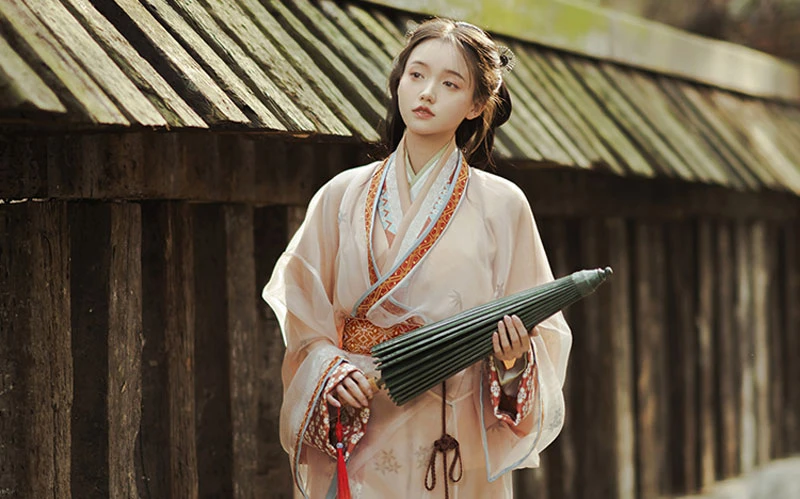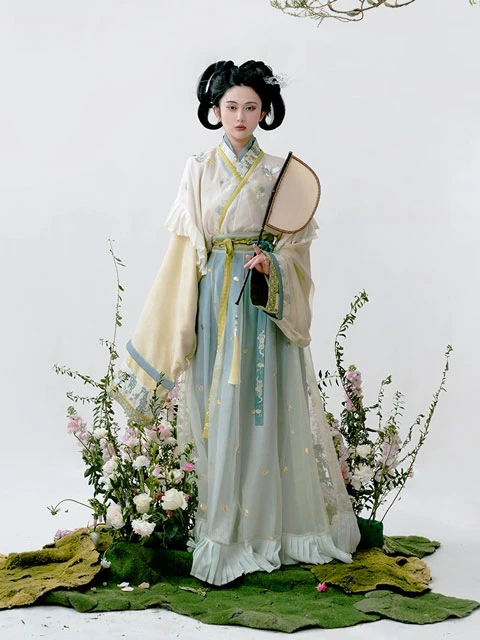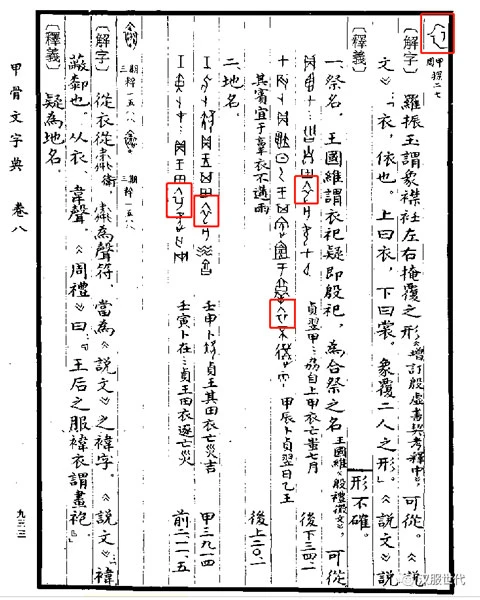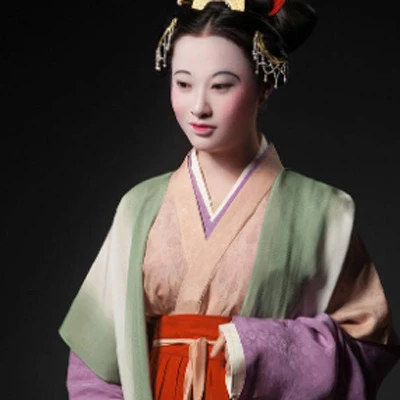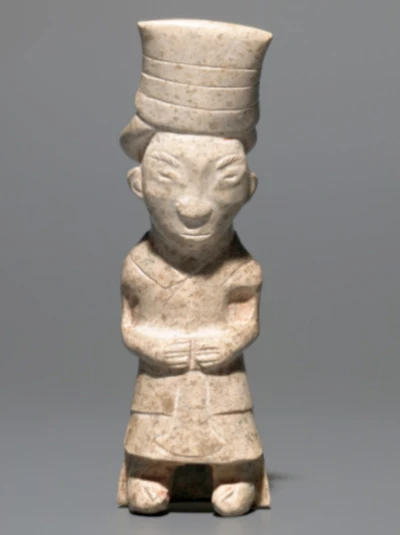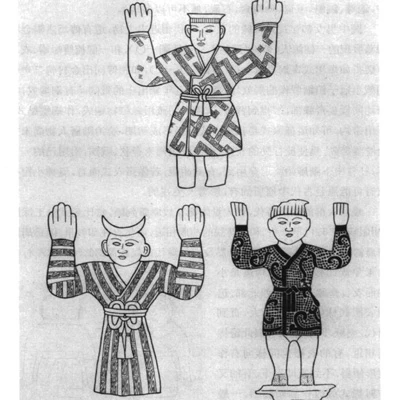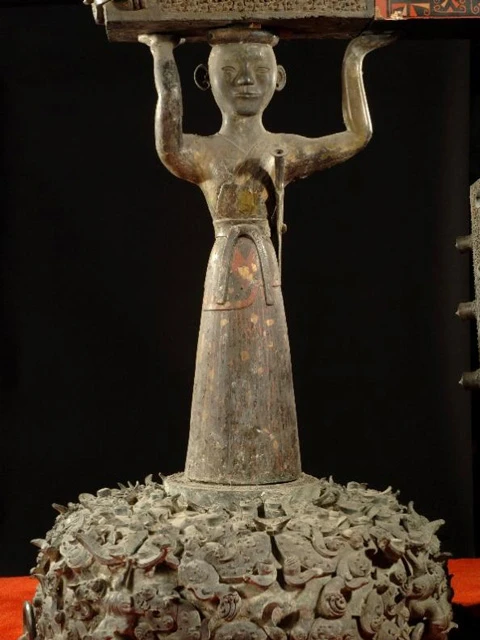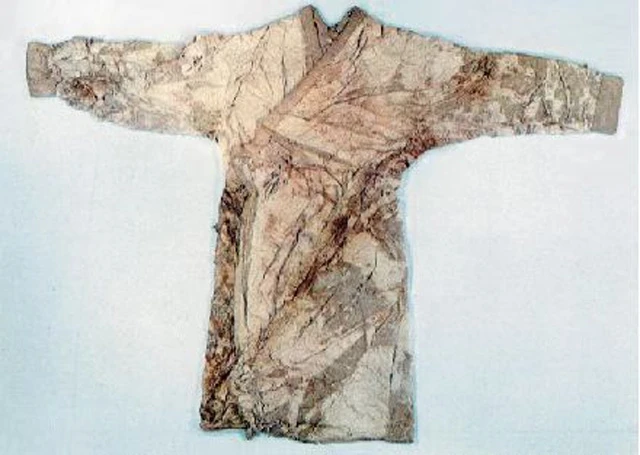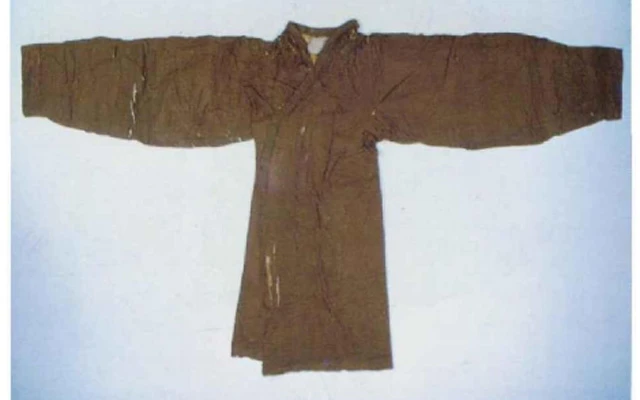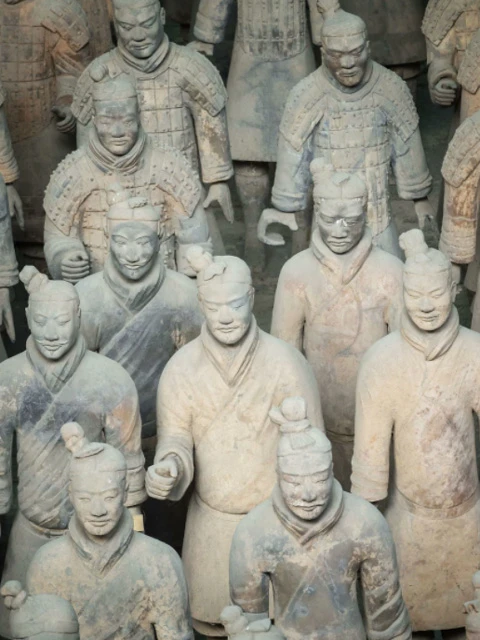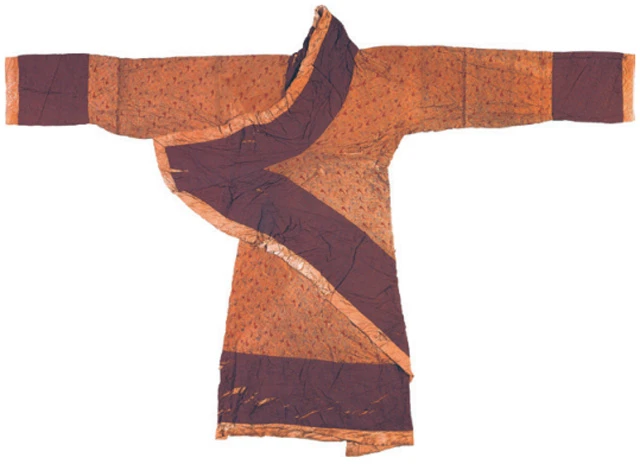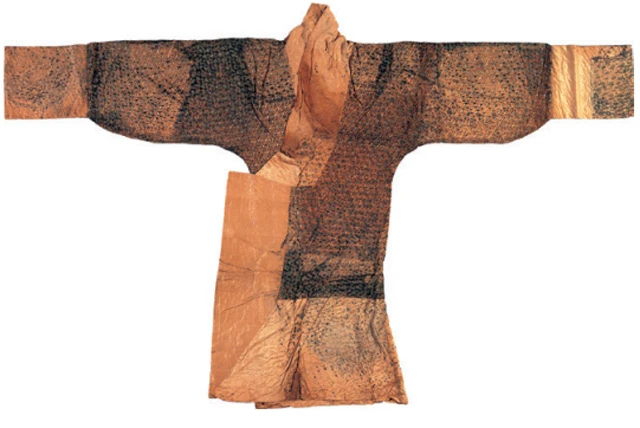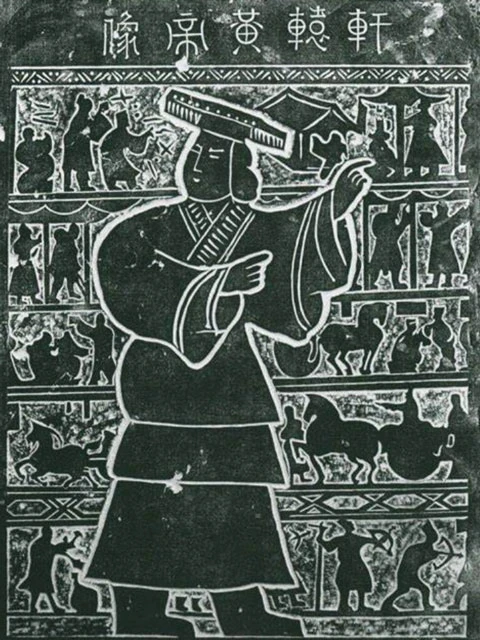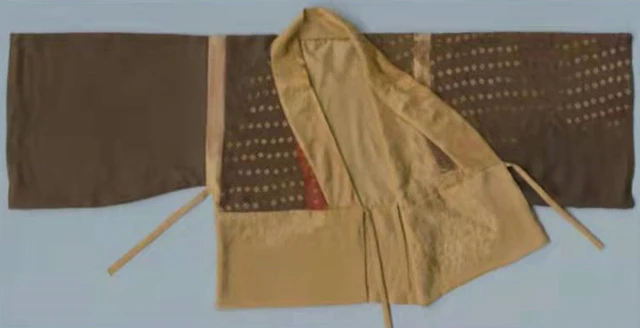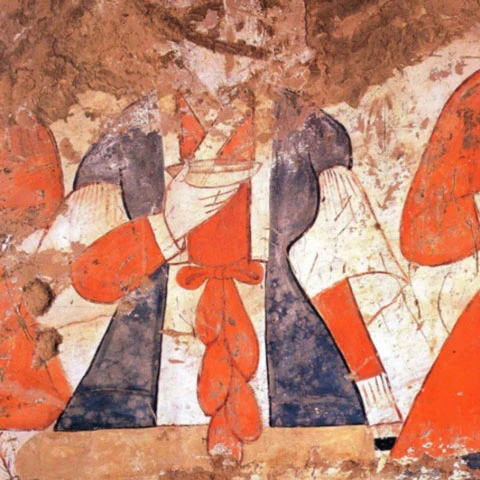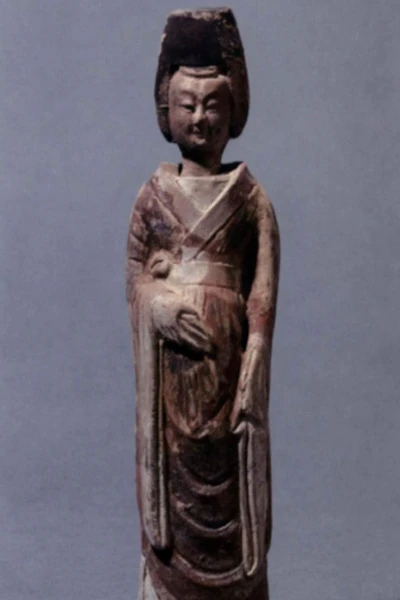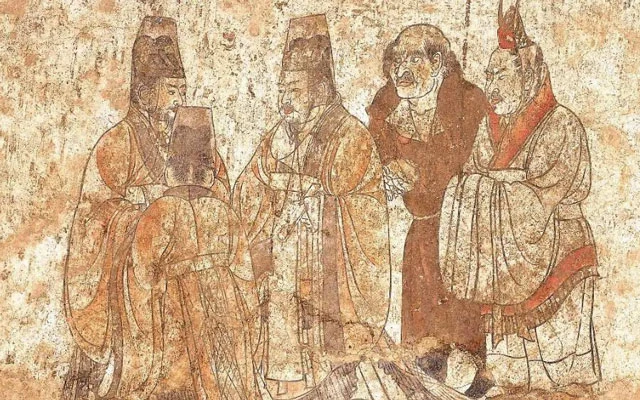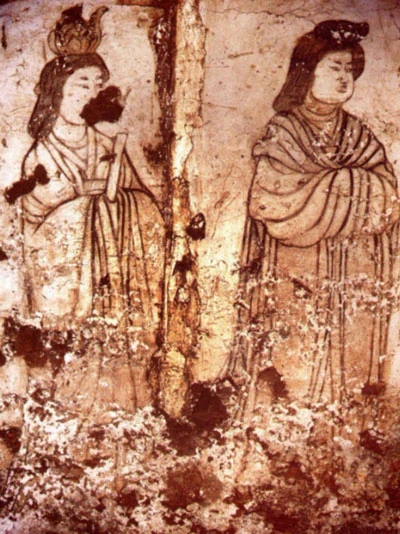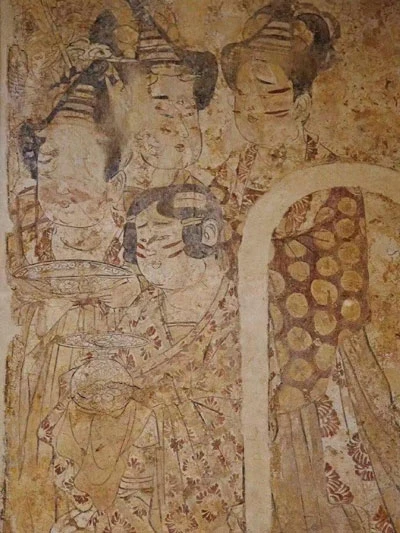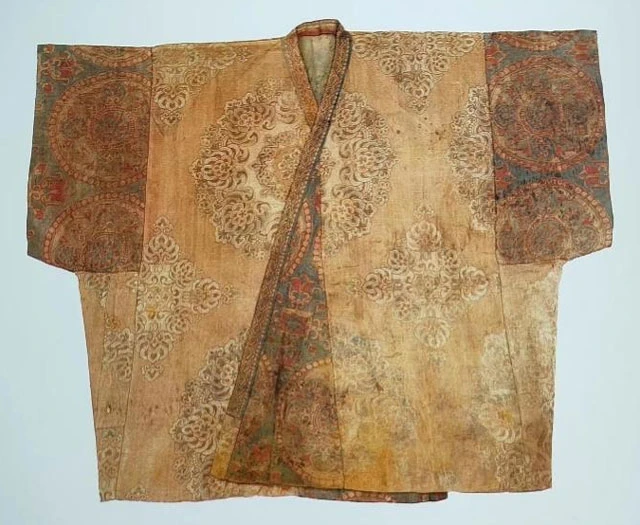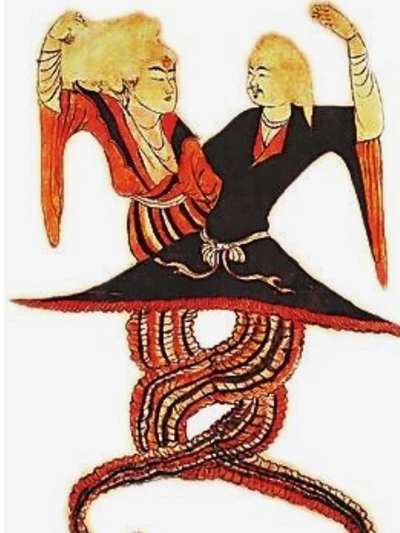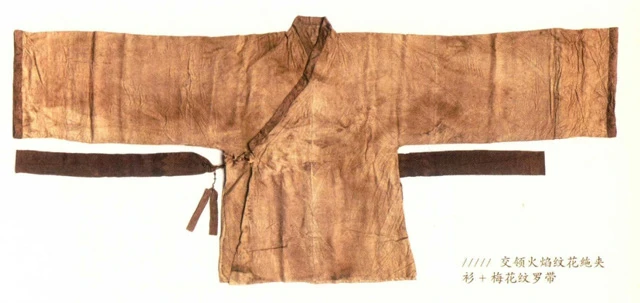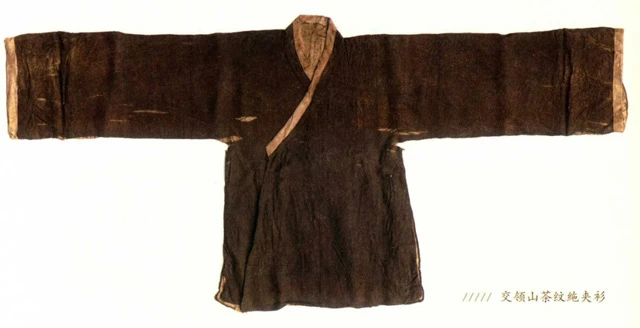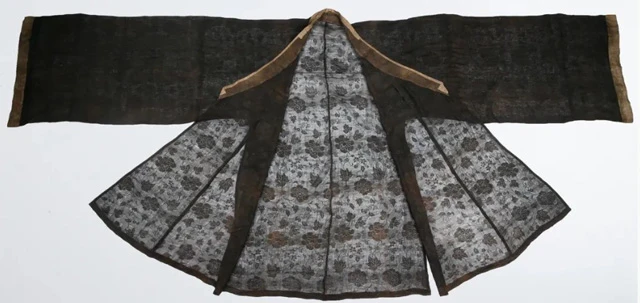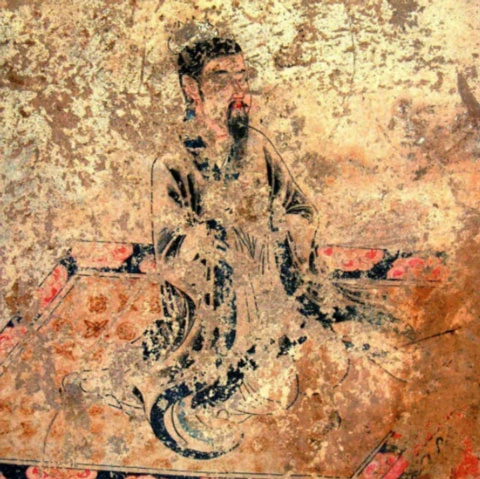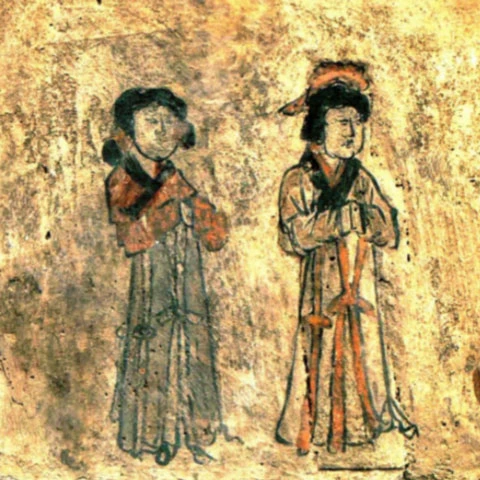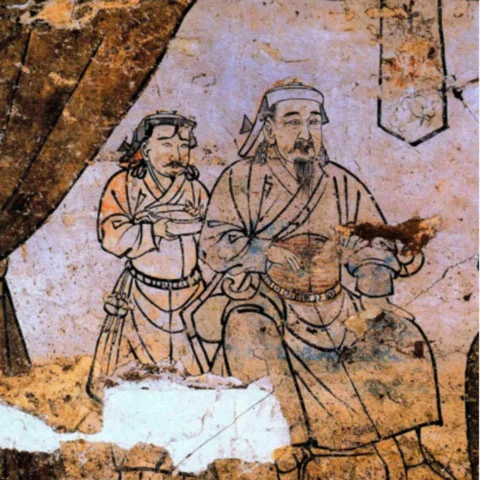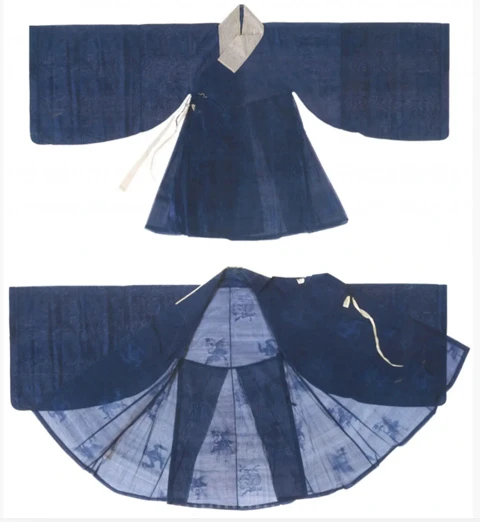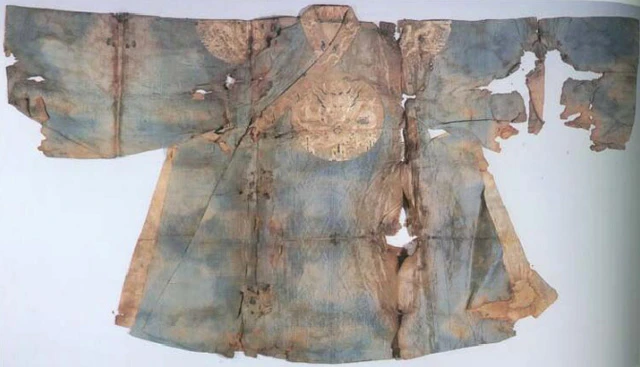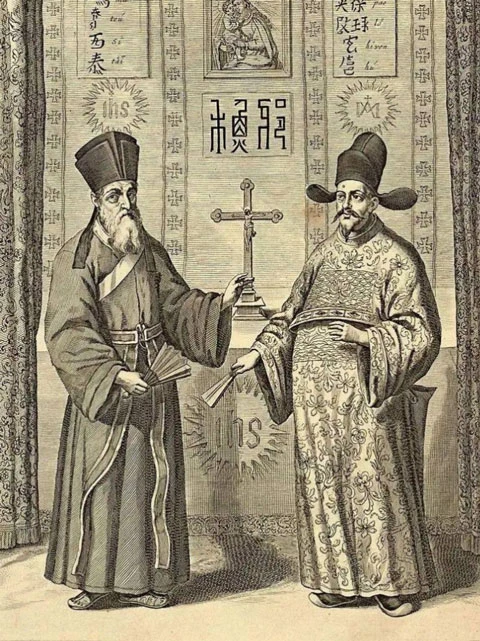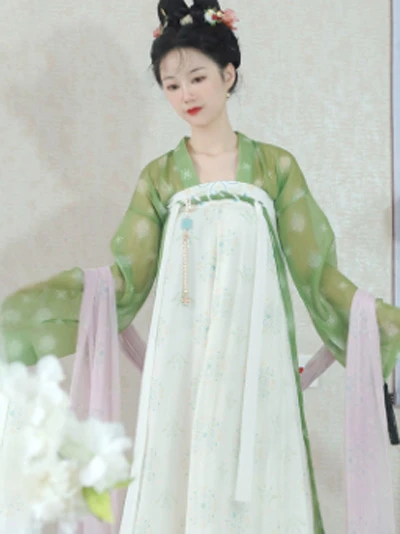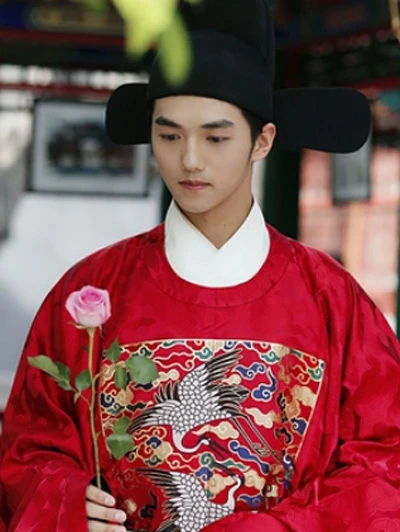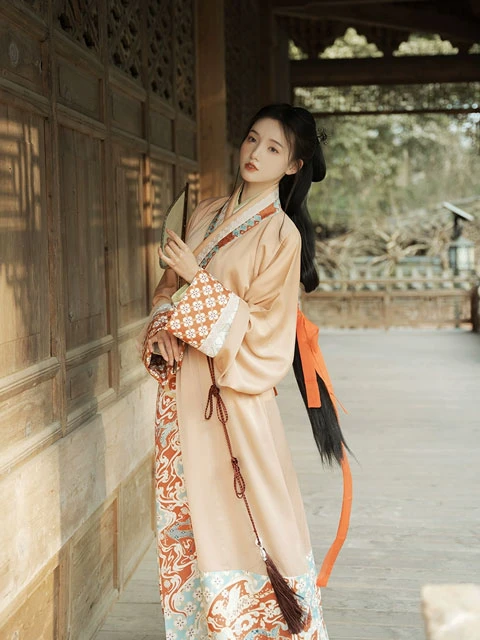The "Jiaoling Youren (交领右衽, cross-collar-and-right-wrapped, the left lapel covers the right lapel when wearing)" based on flat cutting is a typical collar that has been passed down in the Chinese civilization for thousands of years.
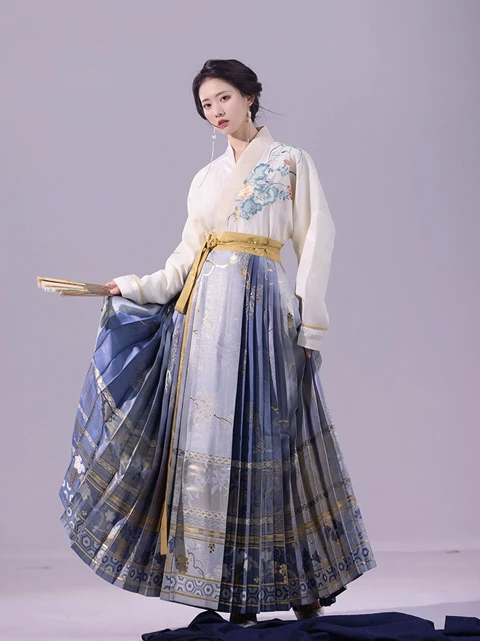
It fully embodies the diverse and integrated pattern since ancient times, carries Chinese common cultural connotation as a nation, and is a symbol of the spiritual essence extracted from the long history of Chinese civilization.
Chinese traditional costumes are profound and have a long history, Jiaoling Youren is like main threads linking thousands of years' of flowery clouds together to inherit continuously with boundless beauty. The character "衣 (clothing)" already existed in oracle bone script which reveals its structural feature: two lapels overlap each other forming into textual symbols.
01 What is Jiaoling Youren
One of the most prominent features of Hanfu is the collar design that crosses left over right to form a "Y" shape known as the Jiaoling Youren style. This collar design has more than 5,000 years of history since Zhou Dynasty. Even though Hanfu keeps innovating with different styles such as straight collars, tank tops, and stand-up collars, the cross-collared Hanfu still maintains its mainstream position among these styles.
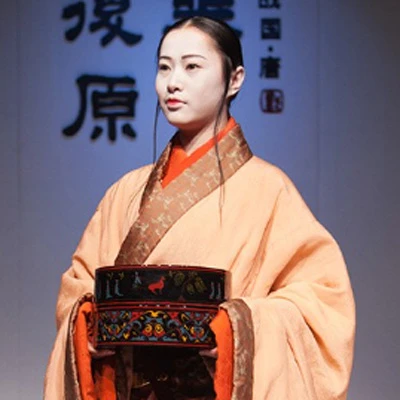
02 The historical evolution of the Jiaoling Youren
Chinese clothing civilization can be traced back to the Paleolithic Age, the character "衣 (clothing)" in oracle bone script clearly reflects the form of "cross-collar" or "cross-wrap." The text has more traceability and stability than clothing, which is why it is reasonable to believe that cross-collared clothes did not emerge only during the Shang Dynasty but originated from a much earlier time in ancient China.
More than 3,000 years ago in Anyang, Henan Province, Chinese ancestors wore Jiaoling Youren clothes for production labor. From relics' images, it can be known that Jiaoling Youren style features symmetrical lapels overlapping each other inside and outside, and mainly fixed by belts, ties, and other accessories.
Ancient texts have recorded that Confucius once said, "行夏之时,乘殷之辂,服周之冕 ", means "Practicing the calendar of the Xia Dynasty, riding in the vehicles of the Shang Dynasty, and wearing the ceremonial hats of the Zhou Dynasty", shows that inherited and continued ancient apparel system.
The Sanxingdui site located in Sichuan Basin also unearthed images of Jiaoling Youren garments. From bronze statues, it can be seen that Jiaoling Youren style features symmetrical lapels overlapping each other inside and outside, and are mainly fixed by belts, ties, and other accessories. This indicates that Chinese civilization has a long history with similar roots. Even though they are separated by mountains and rivers. There still exists an inherent unified connection between them.
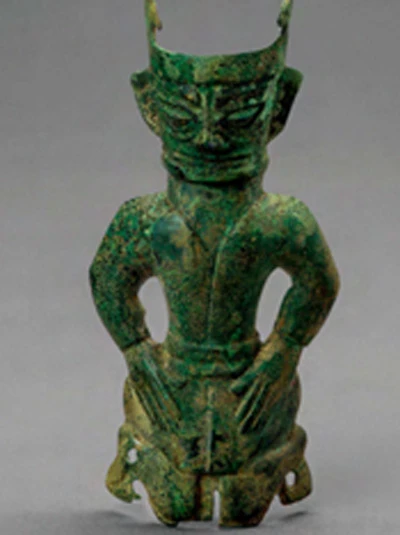
During the Spring and Autumn period about 2,700 years ago, cross-collar-and-right-wrapped garments were still worn with symmetrical lapels overlapped together inside out without using buttons, but fastened up by waistbands. Such as pottery figures excavated from Niu Village, Houma City, Shanxi province, but distinctive collars with a corner.
In the early Warring States period about 2,400 years ago,t he people in the Chu area continued the collar style from this period. The bell-shaped human figures on Bianzhong unearthed from Zenghouyi Tomb in Suizhou, Hubei province reflected similar structures as those found on pottery figures excavated from Niu Village. They were also Jiaoling Youren with symmetrical lapels overlapping each other inside out mainly fixed by waistbands, ties, and other accessories.
Typical relics were also unearthed during the middle-late Warring States Period. Silk clothing items excavated from Mashan No.1 tomb, Jingzhou City, Hubei Province feature Jiaoling Youren with symmetrical lapels overlapped together inside out mainly fastened up by waistbands, ties, and other accessories.
The Qin Dynasty around 2,200 years ago is best known for its terracotta warriors of which most wore Jiaoling Youren garments featuring symmetrical lapels overlapping each other inside out.
During Western Han dynasty around 2,200 years ago, the basic structure of collar continued since pre-Qin times. Written texts handed down or discovered through excavation repeatedly described clothing culture passed down through generations. Han portrait stones, murals, pottery figurines scattered throughout the country during the Eastern Han period fully embodied the universality and foundation of Jiaoling Youren garments.
For example, the earliest portrait of Huangdi was found on an Eastern Han portrait stone. Huangdi wore a crown on head and Jiaoling Youren garments, reflected the collective memory of traditional clothing among people in Eastern Han dynasty.
Traditional Chinese clothing acquired a new name during the Western Hans dynasty: "Hanfu." From then on, like "Han people" and "Han Zi (Chinese characters)," it gradually became a special term for the Chinese nation.
During the Wei and Jin period about 1,800 years ago, a term called "Yi Guan Nan Du (Costume system spread southward)" emerged. However, in reality, the original Hanfu system continued to exist and was passed down in the China Yellow River Basin.
Relics unearthed from Xinjiang reflect the diversity of Chinese clothing. Although these Western Region beautiful clothes were not traditional Chinese clothing, they coincidentally adopted the same collar structure.
Careful examination of various relics from the Wei and Jin periods revealed a common structural pattern: Jiaoling Youren, with symmetrical lapels overlapping each other inside out mainly fixed by waistbands, ties, and other accessories.
During the Eastern Jin dynasty and the Southern dynasties that followed, this point does not need to be elaborated. Jiaoling Youren garments dominated.
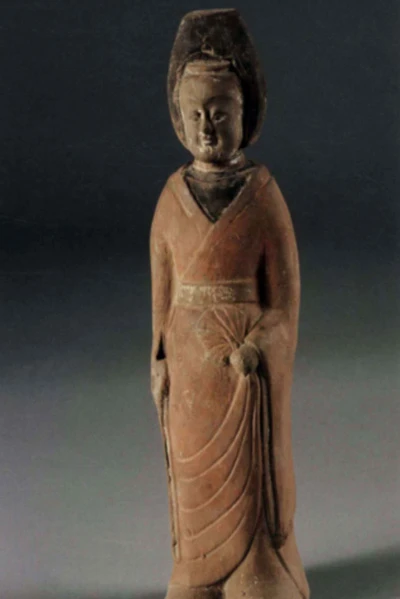
In Northern dynasties' territories, Jiaoling Youren garments were also popular among both Huaxia ethnic groups and non-Huaxia ethnic groups. Although Northern dynasties' dress retained characteristics of different ethnic groups, it also widely used cross-collar structure which fully demonstrated that Chinese civilization has a commonality of "seeking similarities while tolerating differences."
During the Sui-Tang dynasty around 1,400 years ago, the round-neck robe featuring crossed-lapels gained popularity. However, Jiaoling Youren structure was still commonly found among people regardless of gender or social status. Imperial officials, literati, knights, and ordinary men and women all wore such clothing structures. It was like today's basic shirt, a very ordinary style.
The most common dress for Tang women was a three-piece set consisting of a chest-high skirt, shirt, and scarves. Most of them could only see the upper part of the collar and lapel of the shirt, and sometimes the shallow interlocking collar could only show the part of the opposite lapel.
The model of the blouse unearthed in Famen Temple is in fact a right overlapping model with a very shallow interlocking collar, judging from the cut.
The Tang Dynasty was a period of frequent foreign exchanges, and some clothing combined elements of Hu clothes with Han Chinese characteristics.
The Hanfu system is open and broad like concentric circles spreading outwards. It has overlapping and blends transitional zones with other clothing cultures, demonstrating creativity and richness after cultural collisions.
In addition to secular portraits, divine images are no exception. In this Tang Dynasty Fu Xi Nu Wa picture, women's clothes have crossed collars outside and curved collars inside while men's outerwear has round necks that fold over as lapels while their innerwear has round necks. This reflects common dressing habits at that time. It can be seen that people at that time wore various collar styles together. Jiaoling Youren garment was one of the more common ones.
After the chaotic Five Dynasties period came the establishment of the Song dynasty about 1,000 years ago which inherited the Huaxia Hanfu system and further developed it on this basis.
These artifacts fully demonstrate the basic features of Hanfu: Jiaoling Youren garment, with symmetrical lapels overlapping each other inside out. Besides being fixed by ties, the buttoned loop was also introduced which had its own era-specific characteristic. Although Song Dynasty women mainly wore Baizi, and Shanzi with fronts opening on opposite sides, cross-collar structure remained an essential style.
Liao Dynasty implemented a dual-track system divided into "Guo Fu" and "Han Fu."
The Jin Dynasty predominantly used left-wrapped garments, but there were also some right-wrapped garments.
The Yuan Dynasty also used Jiaoling Youren garments.
After the establishment of the Ming Dynasty in 1368, Zhu Yuanzhang "inherited from Zhou and Han, and took from Tang and Song," further inheriting and developing the Hanfu system.
There are countless images and literature records of Jiaoling Youren garment during the Ming Dynasty, with excavated artifacts found throughout the country. As a basic style worn by people of all ages, genders, ranks and statuses, various forms of it have been prevalent throughout history.
Although there were many fashion trends for women's clothing at the end of Ming dynasty, Jiaoling Youren top remained a common basic style that was not replaced by fashionable clothes at that time.
Not only do literary records show this trend but archaeological discoveries as well demonstrate that women still commonly wore various styles of Jiaoling Youren dresses in parallel with other fashions at the end of the Ming dynasty.
During the Ming dynasty, western learning came eastward; missionaries came to China one after another engaging in academic cultural exchanges with Chinese elites.
The portraits of the famous missionaries Matteo Ricci and Xu Guangqi fully illustrate the openness and tolerance of Chinese civilization and the spiritual quality of accepting all rivers.
03 The cultural significance of Jiaoling Youren
Chinese culture values the harmony between yin and yang, which can be reflected through the balance between left and right. Just like the character "汉" in "Hanfu," with its last two strokes crossing over each other to create a balanced shape.
The shape on the right side of "汉" is very similar to that of the collar on cross-collared-and-right-wrapped garments, indicating that Hanfu also embodies cultural implications of balance and harmony.
The inner ties in Hanfu ensure a balanced distribution of force for clothing. A Hanfu top has at least four ties: two on the left and two on the right. Similar to writing strokes for characters, one must first fold the right lapel over to the left and secure it with a tie before folding over and securing the left lapel to the right.
Why does Hanfu emphasize "right"? This is because China has long revered "right" since the Shang Dynasty times, which gradually became an established tradition among Chinese people as well as a characteristic feature of their traditional dress.
Therefore, there is an easy way to identify Hanfu: by checking if there are inner ties inside after receiving clothes. Although some people may replace these ties with buttons nowadays, tying strings remain more flexible & convenient when fitting different body types so they still dominate mainstream Hanfu trends even today. As one carrier of Chinese culture, Hanfu's every component carries unique cultural meanings & development patterns.
04 Variations of Jiaoling Youren
Jiaoling Youren is the most basic and fundamental collar form in Hanfu. While adhering to cultural rules, new collar shapes are created through reasonable variations. The first variation involves transforming the cross-shaped collar into a parallel one, known as straight collars with opposite fronts. This style is also common in Hanfu and can be fastened with just one pair of ties or left hanging naturally.
This straight collar Hanfu style fully embodies Chinese unique aesthetic for clothing. Traditional Hanfu prefer natural draping; at the same time, by pairing suitable colors and patterns, they convey spiritual values of harmony between nature and humanity.

This loose-fitting attire is very comfortable to wear and can be warm in winter yet cool in summer if made from appropriate fabric material, economical while allowing easy movement without sacrificing overall neatness.
The second variation of Jiaoling Youren involves changing the shape of left & right lapel pieces into a circular neckline. As seen from pictures below even when it becomes round-necked, Hanfu still follows traditional dress making principles: the front cloth pieces must criss-cross across each other while maintaining balance; ties remain as primary means for securing them together.
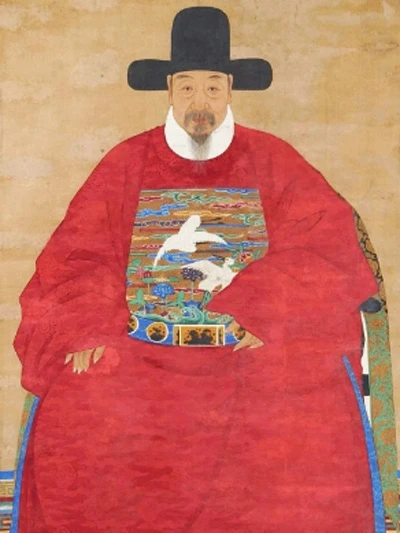
05 Seeking common of traditional Chinese clothing
When we consider Jiaoling Youren to be a representative symbol that captures thousands of years' worth of typical features. Collars such as round collars, square collars, vertical collars, stand-up collars are equally significant components which reflect Chinese profound cultural heritage in terms of dress code throughout centuries past.
There are hundreds types of collar designs within traditional Chinese attire alone; they represent valuable cultural resources that can either be era-specific or region-specific belonging to certain ethnic groups - collectively forming the diversity present in broad range attire culture across China.
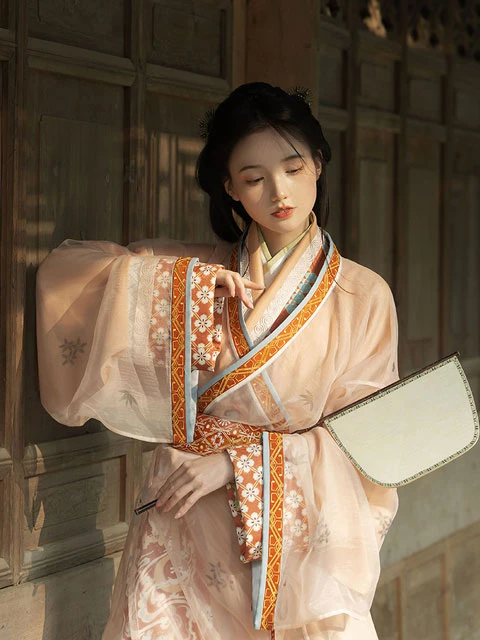
Using Jiaoling Youren as symbolic representation for traditional Chinese apparel may serve as a book cover; however it is important to note that this does not encompass all aspects related to the subject. This cover holds high recognizability within the world culture sphere, allowing people to better understand and appreciate this unwritten history of traditional Chinese clothing.
Hence, we can conclude that shared cultural symbol Jiaoling Youren possesses unique charm and enormous influence in the world - much like chopsticks, Spring Festival or pandas. It is not only a cultural symbol of Hanfu, but also a legacy belonging to all ethnic groups across China.
